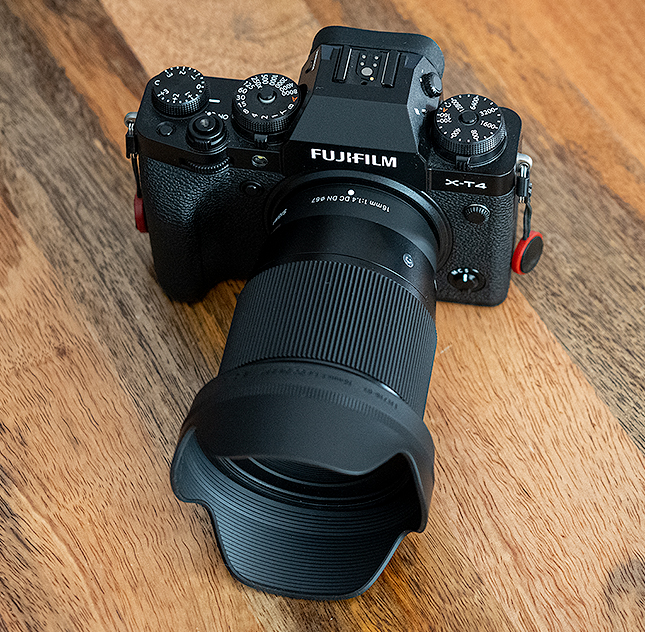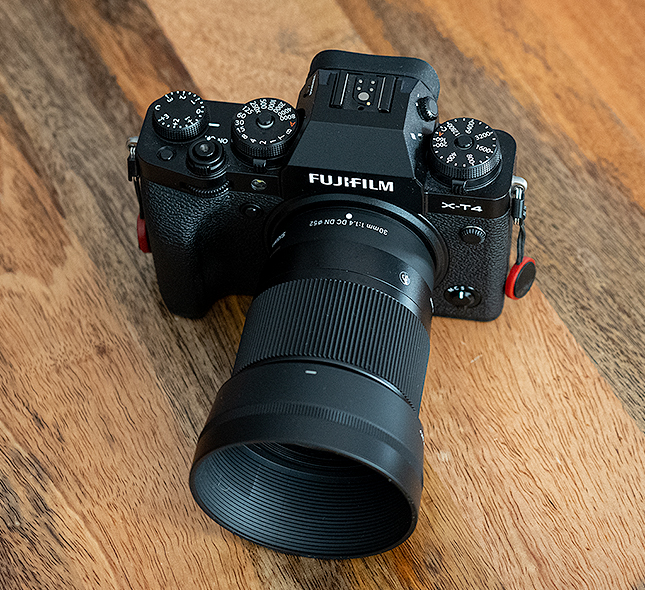Sigma releases trio of F1.4 primes for Fujifilm X Mount, Sigma’s first X Mount lenses
posted Monday, February 21, 2022 at 7:00 AM EST

Sigma has announced a trio of prime lenses for Fujifilm X Mount mirrorless cameras, the 16mm F1.4 DC DN Contemporary, 30mm F1.4 DC DN Contemporary and the 56mm F1.4 DC DN Contemporary. If these lenses sound familiar, it's because they're currently available for Canon EF-M mount, Micro Four Thirds mount, L-mount and Sony E-mount.
As evidenced by the 'DC' designation of these new lenses, they're designed for APS-C image sensors. On a Fujifilm X Series camera, the 16mm, 30mm and 56mm lenses are equivalent to roughly 24mm, 45mm and 84mm primes, offering wide-angle, standard and short telephoto focal lengths. The angle of view provided by each lens is 83.2, 50.7 and 28.5 degrees, respectively.
Sigma 16mm F1.4 DC DN Contemporary
Let's take a closer look at each lens in turn. First, the Sigma 16mm F1.4 DC DN C lens is 92.6 millimeters (3.6 inches) long and has a max diameter of 72.2mm (2.8"). The lens has a 67mm filter size, the largest diameter filter of the three lenses. It's also the heaviest lens, coming in at 405 grams (14.3 ounces). The lens features a weather-sealed construction.
Optically, the lens has 16 elements in 13 groups. Among these elements, there are two SLD glass elements, three FLD elements and two aspherical lens elements. The lens also includes Super Multi-Layer Coating to suppress flare and ghosting.

Autofocus is provided via Sigma's stepping motor system, which promises quick, quiet and smooth focusing performance for both stills and video. The minimum focus distance is 25 cm (9.8"), resulting in a max magnification ratio of only 1:9.9. The lens supports Fujifilm's High-Speed AF feature and supports in-camera aberration correction.

The Sigma 16mm F1.4 DC DN C lens will be available from authorized retailers in April for $449. If you own the lens, or the other two new lenses, in a different mount and want it converted to X mount, Sigma offers mount conversion services.
• Read our Sigma 16mm F1.4 DC DN Contemporary Hands-on Review •
Sigma 30mm F1.4 DC DN Contemporary
The Sigma 30mm F1.4 DC DN C lens is the lightest of the new lenses, weighing 275g (9.7 oz.). The lens is 73.6mm (2.9") long, and its max diameter is 64.8mm (2.6"). The lens has a 52mm filter thread, the smallest of the three lenses.
The 30mm F1.4 DC DN C features nine elements across seven groups, including a single high-refractive index element and two aspherical elements to limit distortion and spherical aberrations. Like the 16mm lens, the 30mm prime includes Super Multi-Layer Coating to minimize flare and ghosting.

Focus is provided by a stepping motor, and the system is designed for both still and video applications. The minimum focusing distance is 30cm (11.8"), resulting in a max magnification of 1:7. Like the 16mm lens, the 30mm F1.4 DC DN C isn't designed for macro work.

Like the 16mm, and the 56mm lens we have yet to discuss, the 30mm F1.4 DC DN will be available in April. Its suggested retail price is $339.
Sigma 56mm F1.4 DC DN Contemporary
Of the three new prime lenses for X Mount, the Sigma 56mm F1.4 DC DN C has the longest focal length. This means, all else equal, the 56mm F1.4 DC DN C promises the smoothest bokeh performance of the three new prime lenses. It should be well-suited to portrait applications, although you can make a case for capturing portraits with each of three new lenses. Like the other two primes, the 56mm F1.4 DC DN C includes a nine-bladed round aperture diaphragm.
The 56mm F1.4 DC DN C lens weighs 280g (9.9 oz.), so just slightly more than the 30mm F1.4 DC DN C. However, at 59.8mm (2.4") long, the 56mm lens is quite a bit shorter than the 30mm prime. The max diameter is similar at 66.5mm (2.6"), although the increase in diameter results in a slightly wider 55mm filter thread.

The 56mm F1.4 DC DN C lens features 10 elements in 6 groups. Special optics include two aspherical elements and a single SLD element. Following the trend, Super Multi-Layer Coating is also included. Again, autofocus is provided via a stepping motor. The minimum focus distance is 50cm (19.7"), which results in a 1:7.4 max magnification ratio.

The Sigma 56mm F1.4 DC DN Contemporary lens will be available in April at a suggested retail price of $479, which is the highest of the three lenses.
• Click here to view our Sigma 56mm F1.4 DC DN Contemporary Gallery •
How do the new Sigma lenses compare to Fujifilm's primes?
The Sigma 16mm F1.4 DC DN C lens fills the same role as Fujifilm's XF 16mm F1.4 R WR lens. However, whereas Sigma's DC DN C lenses offer good performance at a more palatable price, the Fujifilm XF 16mm F1.4 R WR is a full-blown professional prime lens. Fujifilm's lens is $999, more than twice the price of Sigma's new 16mm F1.4 lens.
Fujifilm doesn't make a 30mm prime lens for its XF system. However, it does make the XF 33mm F1.4 R LM WR lens and the older XF 35mm F1.4 R. The XF 33mm F1.4 R LM WR lens is $799. The older XF 35mm F1.4 R lens is $599. At $339, the new Sigma 30mm F1.4 DC DN C is an affordable alternative.

Fujifilm makes quite a few lenses that serve the same purpose as the 56mm F1.4 DC DN C lens, although none are F1.4. There's the XF 50mm F1.0 R WR, which is a super-fast, large prime lens that costs $1,500. Although it has roughly the same price ($44), the XF 50mm F2 lens is slower than the Sigma lens.
Fujifilm's lineup includes two 56mm prime lenses. They're both F1.2 primes. The XF 56mm F1.2 lens is $1,000 and the XF 56mm F1.2 APD adds an apodization filter and is $1,500.
What's next for Sigma and the X Mount?
Looking ahead, Sigma has also announced that more lenses will be coming soon in X Mount. Specifically, the Sigma 18-50mm F2.8 DC DN Contemporary lens will be coming later this year. The tentative release window is December.
Hands-on with the Sigma F1.4 Primes for X Mount
(by William Brawley)
Just prior to the announcement, we were sent this trio of new Sigma primes for X Mount. However, all three lenses were pre-production prototype models, so we can't yet review these nor share any full-resolution images shot with them. However, we *have* previously reviewed the Sigma 16mm F1.4 and 56mm F1.4 lenses, just on different camera mounts. If you haven't read those in-depth hands-on reviews yet, I encourage you to check them out.

Nonetheless, having these beta-sample lenses helps get a sense of how the lenses look and feel and how they pair with Fujifilm X Series cameras, which, in my case, was the Fuji X-T4. I've not had the opportunity to use any of Sigma's F1.4 DC DN primes before, so upon first picking up the lenses, I was amazed not only by how light they all were but also how solid and well-built they felt, despite their lightweight designs. The 16mm lens is the largest of the three, both in terms of physical size as well as weight. The 16mm uses 67mm filter thread and has a noticeable "heft" to it when holding it. Still, it's far from what I'd consider a heavy lens (it still weighs under a pound) and balances easily with a camera like the X-T4.

The 30mm and 56mm version, on the other hand, are both tiny lenses, and while not identical in size and shape, they both weigh about the same and take smaller filter sizes than their 16mm sibling. (It's unfortunate, however, that both of these don't use the same filter size; the 30mm uses 52mm filters, while the 56mm uses 55mm filters.) Picking up either of these lenses, you really notice and can appreciate their lightweight design. They still feel very solid but are just very light. This makes them very easy to carry around, and they operate well on camera bodies both big and small. All three lenses share similar characteristics for design and construction, with all three barrels constructed from what I can tell to be both metal and Sigma's Thermally Stable Composite material. The lens mounts themselves are made of brass, and like the other mount versions of this lens (except the EF-m version), they all feature weather sealing throughout -- including a nice gasket around the lens mount.

All three lenses are also quite sparse when it comes to external features. There are no focus switches, custom function buttons, and as you can see from the photos, there is no manual aperture ring that you normally see with most of Fujifilm's own Fujinon X Series lenses. When mounted on the X-T4, the front sub-control dial controls the aperture of these lenses when in Manual or Aperture Priority exposure modes. The three lenses all feature large, deeply-ridged focus rings, with the 16mm's being noticeably larger than the other two. The feel of focus ring rotation is some of the smoothest I've ever felt. They are buttery smooth. However, the rotational resistance is maybe a bit light for my tastes, particularly the 56mm lens. It feels like you could easily bump the focus ring and change focus if you're not careful. That said, if you shooting with autofocus enabled, this is a moot point.


All in all, Sigma's created three fantastic primes for Fujifilm X Series owners. As mentioned, these three lenses had been released earlier for other crop-sensor camera systems, with Fujifilm X-mount being notably absent. It's nice to see Sigma expanding its lens offerings to the Fuji X Series family.




